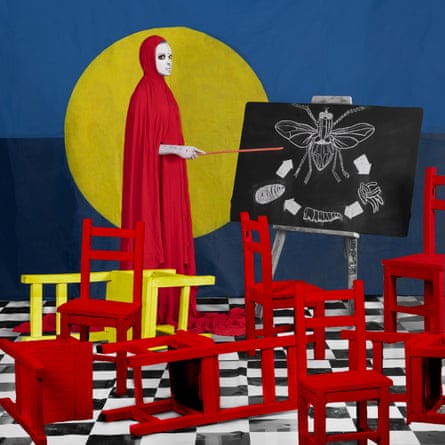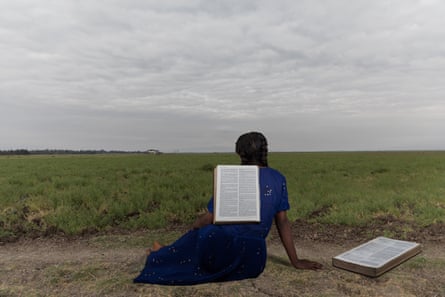[ad_1]
At first, they look like studio portraits, reminiscent of the jubilant style of Malick Sidibé. Against lime and verdant green fabrics fashioned into makeshift backdrops, the subjects face the camera. But they do not return our gaze. They are blind.
The portraits are part of a series by the award-winning photojournalist John Kalapo – who worked for a time as a digital archivist preserving the work of Malian photography legends, including Sidibé. In this series, the history of Malian studio portrait photography and documentary converge, as Kalapo evokes the devastating effects of onchocerciasis, known as “river blindness” – a tropical skin disease caused by a parasitic worm – in the Malian villages of Sagabary, Boukarybaye-Bohan, and Kita town.
The portraits are included in the exhibition Reframing Neglect organised by the EndFund, a private philanthropic organisation working to end neglected tropical diseases (NTDs) – 20 conditions that disproportionately affect impoverished communities around the world. Working with activist, artist and entrepreneur Aïda Muluneh, the End Fund commissioned seven African photographers to create bodies of work to inform the viewer on NTDs. The works are also couched as a riposte to the long history of photography of Africa’s problems by white, western charitable organisations.

Putting pain into pictures is a tough task, and photographing the suffering of others remains an extremely contentious activity. Reframing Neglect is an attempt to find a new vocabulary for visualising illness and pain in Africa. Muluneh, the best-known artist in the exhibition, has become a figurehead for this new autonomous visual language of – and for – African issues, shifting the viewer from pity to empathy.
The Ethiopian artist’s conceptual approach combines feverish colours and symbolism with traditional east African body painting techniques in highly choreographed, surreal scenes. You can take the images at face value – they are beautiful and evocative. They also offer allegories about the impact of NTDs: motifs of insects refer to the vectors of invisible, life-altering diseases. In another image, a figure dressed in red stands in a deserted classroom, pointing at a diagram on a blackboard depicting the life cycle of an infectious insect. Embedded in these images are the signs of struggle, as well as a history of survival.
More classical documentary-style images focus on collaboration and individual dignity. Sarah Waiswa spent time with Eunice Atieno, a 48-year-old single mother who has been living with lymphatic filariasis (LF), another disease caused by parasitic worms and a leading cause of permanent disability worldwide. Atieno was diagnosed in 2019, following a mass drug administration exercise that took place in her neighbourhood. Waiswa’s documentation unfolds as an extended portrait, showing vignettes of Atieno’s everyday life as she attends medical appointments and cares for her child at home. Yet the camera remains at a respectful distance – a reminder that this is someone else’s life, inviting reflection rather than action.

It is not always about what a picture shows. Sudanese documentary photographer Ala Kheir worked with individuals in the Stables Industrial Area on the outskirts of Khartoum. Most of the community living there are migrants fleeing conflict elsewhere, and they are gravely affected by NTDs. Kheir’s illusory black and white images attempt to put the problem in a wider context, connecting the city’s architecture and the impact of war across the country with the experiences of its communities. In a haunting suite of double-exposure images, figures are engulfed by the landscapes on which they have been forced to build their temporary homes. The fate of these communities depends on what is happening elsewhere, and the pictures point us there.
As an exhibition of photography, Reframing Neglect is most engaging when it experiments with new forms. Meseret Argaw offers a conceptual series focusing on stories of women living in rural communities in Ethiopia. She combines sculpture and performance, staged, dreamlike scenes of female figures who appear isolated or excluded. They are mesmerising and mysterious interpretations of the experience of living with an NTD – Argaw comes the closest to finding an expression that is artistic and stirring, without being descriptive or illustrative.
There is something raw about this show, as it grapples with photography as both an effective and problematic tool of consciousness-raising, veering from on-the-nose documentation to conceptual art. But it contributes to a discourse and burgeoning style that is still being formed after decades of seeing Africa’s issues through a western lens. But ultimately, this isn’t an exhibition about photography. And if you walk away from the exhibition thinking about the photographs, they haven’t done their job.
[ad_2]